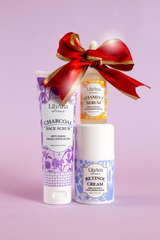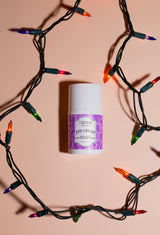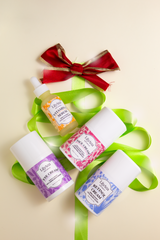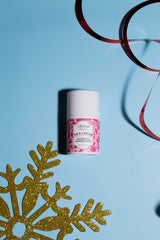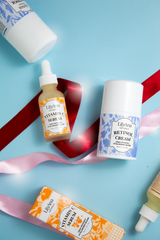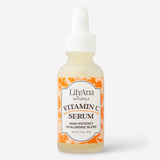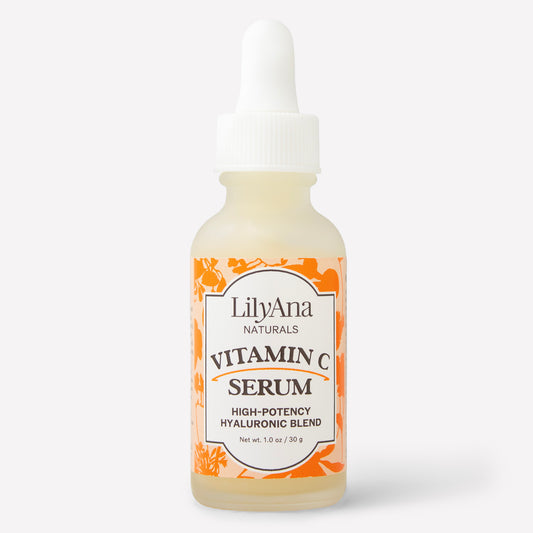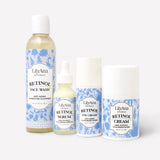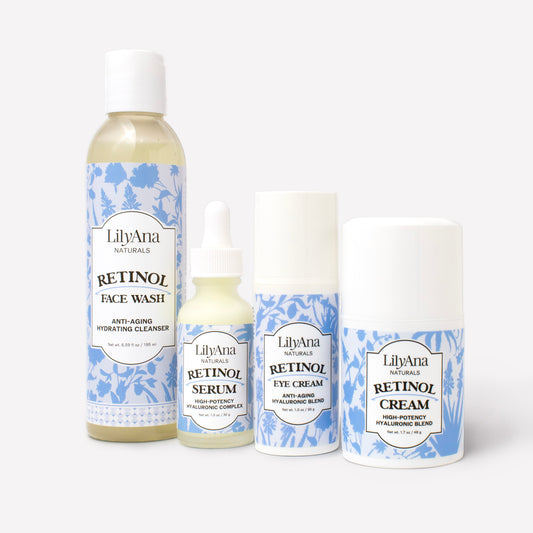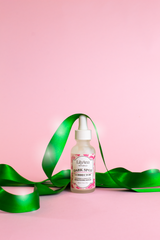I started using retinol and now my skin is freaking out. I thought my new retinol cream was supposed to help me!
Such sayings have been heard many times in the dermatology world when we talk about the ever-popular retinol. Known for its amazing collagen and anti-aging benefits, anyone interested in skin science today has probably heard of this mighty ingredient.
But as you might already know from experience, retinol can be notorious for its side effects. Peeling, redness, and irritation are common onset reactions for some people when they first start to use retinol. Some reactions get so bad that the common term used to describe the list of effects has been dubbed the “retinol uglies”.
Note from a skincare expert: Many things in life get worse before they get better. Pimples, peeling, and redness often occur after the initial use of retinol. Retinol draws the toxins and bacteria to your skin’s surface, then it sloughs off old skin that is blocking young, clearer, dewier, and healthier skin.
Luckily, these aren’t permanent damages and there are ways to prevent the yuck. Before you give up on retinol, here is everything you need to know about treating -- and preventing -- the retinol uglies.
What is Retinol?
Retinol is a type of skin care ingredient that is hyped for its skin healing and smoothing properties. You can file retinol under the broader term, “retinoids”, which are medical elements derived from vitamin A.
Retinoids have been developed and used for decades in treating acne, diminishing fine lines and wrinkles, and improving overall skin texture and appearance.

Retnol vs Retinoids
Retinoids are more powerful, concentrated compounds that usually require a prescription, whereas retinol is a subtler form of retinoids.
Retinol can be bought over-the-counter at drugstores and doesn’t require a prescription, like most retinoid products. Retinols are applied topically in the form of creams, gels, or lotions. Retinoids can be topical, but they can also be oral medications. Accutane is an example of prescription retinoid treatment.
What Makes Our Retinol Products Different
You’re way less likely to experience ugly side effects when using LilyAna Naturals retinol products.
To make our retinol products less concentrated and gentler on your skin, we use a proprietary blend of retinol cream, niacinamide, and hyaluronic acid.
If you want to avoid nasty side effects with the best and gentlest retinol products the skincare industry has to offer, add one or more of these to your medicine cabinet:
- Retinol Cream (our best-seller)
- Retinol Serum (award-winning serum for a more potent retinol experience)
- Retinol Face Wash (designed to calm and prep the skin for retinol products)
- Retinol Eye Cream (say goodbye to tired and puffy-looking eyes)
There’s a reason our Retinol Cream has a 5-star rating with over 16,000 reviews. Shop retinol products now!

What Does Retinol Do?
Both retinoids and retinol help to speed up the process of skin cell turnover. This means the cells in the skin produce and die off at a more rapid pace. New skin cells are able to form, which results in softer and smoother skin on the surface.
Helps Create Collagen
Retinol works in the deeper layers of the skin (called the dermis), not just the epidermis. It stimulates collagen production, which we all want more of. Collagen keeps the skin supple, young, and healthy. It’s also essential for healthy hair and nails, but in this case, retinol boosts skin renewal. Better collagen production means healthier, more elastic skin.
Unclogs the Pores
When pores are clogged, our skin cells can’t regenerate as quickly as they need to. Retinol has a mild exfoliating property where it can prevent pimples, blackheads, and blemishes.

Many people with skin that is prone to acne swear by retinol in the long run because it helps treat and prevent breakouts, while also smoothing overall skin texture.
Note from a skincare expert: This is a good time to say why breakouts may occur in the first place. When retinol clears pores, the pores need to flush and empty out. That's called breakouts and pimples. The only way out is up and out.
Smooths the Skin’s Natural Texture
Working deep into the pores, retinol evens out the structure of the skin. Because it produces and sloughs away skin cells at a faster speed than your skin does on its own, it serves as a mini-facial that boosts rapid skin production. As a result, your skin will probably appear evened out and balanced.
Can Shrink Wrinkles
All of this renewal and smoothing action is bound to show improvements when it comes to wrinkles and fine lines on the face. Many people who love retinol claim the effects they notice most is the minimizing of wrinkles within several months!
Benefits of Retinol for the Skin
If the main results of retinol aren’t enough, here is a longer list of benefits that this powerful skincare ingredient is most famously known for:
- Boosts collagen production
- Faster cell turnover
- Sheds dead skin cells as a natural exfoliant
- Reduces early signs of aging
- Can help manage oily skin
- Decreases the potential for breakouts and blackheads
- Works deep in the skin beneath the surface for real results
- Prevents and shrinks wrinkles
- Evens skin tone
- Clears out clogged pores
- May fade dark spots or hyperpigmentation
- Gentler than prescription retinoid treatments
- Easy to access (over the counter products)
- Helps treat acne and blemishes
Note: Ready to take advantage of these amazing benefits? Upgrade your skin with LilyAna Naturals retinol products now!

Top 3 Side Effects of Using Retinol and What You Can Do for Relief
Although there are plenty of reliable reasons to use retinol, it’s no secret that it is known for the side effects that come with retinol usage. Everyone has different skin which means each individual might have different levels of positive and negative reactions to any new skin product. When we’re talking about retinol, there are some widely seen reactions you should be aware of.
1. Skin Flaking or Peeling (Also Called “Retinol Peeling”)
The most common complaint people share when they start using retinol is that for some people, it causes their facial skin to peel or flake. As we mentioned above, the retinol reactions cause skin cells to die off quicker than usual which can make the skin seem flaky.
Retinol peeling actually means that the product is working, but it can still be alarming to look in the mirror and see flaky skin, especially on your face!
Thankfully, this peeling/flakiness will likely go away on its own over time. The more your skin builds a tolerance to the reactions caused by retinol, the more it will balance itself out.
Relief for retinol peeling
If your skin is peeling or getting flaky when using retinol, the best advice is to be patient and wait it out. We say this with all the love, but sometimes things get worse before they get better. The peeling will eventually go away over time when your skin gets used to retinol.
In the meantime, either slow your usage of retinol or, if you must, apply moisturizer. For extra flaky or dry areas, you can avoid applying the retinol in that spot. You can also spot treat that area with a soothing lotion or hydrating cream, but that essentially stops the retinol from doing what it’s meant to do.
Our skin care experts at LilyAna Naturals greatly prefer the former option -- forgoing retinol on the flaky spot for a day or two.
2. The “Retinol Burn”
Another potential side effect of retinol is feeling a slight burning sensation in the skin, specifically when applying other skincare products after using retinol. Sometimes the retinol burn can be more severe, showing up as the skin becoming red or splotchy in the face.
This is mostly seen among people with sensitive skin in the first few days after the introduction of retinol for the first time, usually only over the first 24 hours. Take comfort in knowing that this retinol burn usually goes away in less than a week.
Signs aren’t always visible with burning, but if they’re visible you just have to monitor your skin and watch for signs of bad reaction or worsening symptoms.
Relief for retinol burning
If you feel the burn or see redness, make sure you avoid intense products or excessive amounts of topical products, including makeup, for a few days. You want to let your skin breathe and it’s best to avoid the introduction of other ingredients that could irritate your skin even more. If you feel discomfort, a cold compress or cool ice packs can help relieve the burning.
3. Redness or Changes in Skin Tone
Even if your face doesn’t burn or feel any tingly sensation from retinol, it can still appear slightly red, pink, or uneven in color. This is pretty normal with some retinol products. A lot of people report that using retinoids causes their skin to change, and that can be upsetting at first. Don’t be concerned, though; these are expected.
Relief for retinol redness
Skin color changes are normal with retinol. Instead of trying to completely control or hide the redness in your face, give it a few days to even out on its own. Try to wear minimal beauty products during this phase, and feel free to take a day or two break from using retinol. If the redness is uncomfortable for you, try using gentle, natural moisturizers to soothe the skin.
What Do the Retinol Uglies Look Like?
Retinol Uglies include all of the above negative side effects of using retinol. The initial stages of retinol use can bring on some rather unsightly and uncomfortable irritation. Don’t freak out if this happens to you.
Know what to expect and learn the things you can do to both prevent and treat the “uglies”. Also called retinization, “the retinol burn”, or retinol irritation, many retinol products of low and high concentrations can bring up the following symptoms:
- Redness
- Uneven skin color
- Burning or stinging sensation
- Dry skin
- Flaking
- Peeling
- Painful skin irritation
- Breakouts
- Blotchy patches of skin
- Changes in texture
- Mild to severe sensitivity
- The “skin purge”
Everyone tends to react differently to the retinoid uglies, so depending on the type of irritation you might experience, here are some ways to start treating them early on.
How to Treat the Retinol Uglies Without Making Things Worse
People do a lot of strange things to try to remedy their retinol irritation, so listen up! To best protect your skin and get through this sometimes difficult (and rather annoying) adjustment period, think realistically about these 5 solutions.
1. Simplify Your Skincare (For Now)
One of the best things you can do to help treat and speed up your relief process is to simplify the things you put on your face every day. This doesn’t mean you can’t ever wear makeup again, it means you need to respect what your skin needs for the next week (or at least several days).
It’s probably a good idea to avoid using any chemically-packed facial products until your face clears up. If you usually wear a lot of foundation and makeup, try wearing less and keeping your look simple for a little while.
This will allow your pores to stay clear of extra irritants. It will also let your skin be able to more effectively do its thing. It’s working hard to regenerate your skin cells and readjust to the new normal.
2. Apply Cold or Ice to Painful Areas
If your retinoid irritations are so bad that you’re feeling pain in your skin, first, make sure it’s bearable and not a severe allergic reaction. Excess swelling, pain, sensitivity to touch, or extreme burning (like a severe sunburn or skin burn) can be a sign you have an allergy to something in the product.
If any of these things happen, seek medical help right away. But if your pain is anywhere in between the minor discomfort to a stinging or burning sensation, this is likely normal.
You can relieve the discomfort by applying cold compresses or ice packs wrapped in a towel. The cold will help relieve any puffiness and pain, especially over the first 24 hours or so.

3. Use Soothing, Cleansing Remedies
Aside from skipping makeup and using cold compresses, there are natural remedies that can soothe your skin during this phase.
Aloe vera gel, topical antihistamines, and cooling toners can help. However, keep in mind that these products can neutralize the positive effects of retinol, so we suggest only using them when absolutely necessary.
Make sure you wash your hands before touching or caring for your face. Rinse your skin with cold water at least once or twice a day to make sure you’re gently washing all those dead skin cells away to speed up the process.
4. Stay Away from Exfoliants
Since exfoliant cleansers and masks can be rough on the skin, it’s wise to hold off on any for now. Remember, retinol has a natural exfoliating effect from the inside out. You don’t want to overdo it by sloughing off the skin cells.
You can use a cotton washcloth to help gently remove the flakies. Wait until your skin calms down (or gets even better!) to start using strong exfoliators again.
5. Seek Advice from a Dermatologist

If you find it hard to tolerate the side effects, seek advice from a dermatologist or doctor. It could be that you’re reacting to another ingredient in whichever product you used, not just the retinol.
Note: This is, again, why we highly recommend using retinol products made by LilyAna Naturals. These products are tested and proven to reduce the risk of side effects compared to most retinol/retinoid products on the market. Browse your options here!
How to Prevent the Uglies Before They Happen
Knowing how to treat retinization is one thing. Knowing how to best prepare your skin before starting to use retinol is a whole other matter you should care about! To avoid the extremes of retinol uglies, equip yourself with the information you need to make any retinoid treatment experience the best you possibly can.
-
Start small and work your way up: Instead of dousing your face with a new retinol product, take it easy at first. Slow and steady wins the race here. Start with a small amount and then work your way up slowly over time, as you observe how your skin reacts. Start using it twice a week and then slowly increase the days as your skin allows. If you like, you can do a spot test first before applying to the whole face. Test a small area on your wrist and wait 12 to 24 hours to see how your skin reacts.
-
Moisturize: Sometimes, you can prevent crazy retinol reactions by “buffering” your new product with a moisturizer. Mix the retinol product in with your moisturizer to have a less aggressive first try.
-
Avoid introducing more than one new product at the same time: To be sure any reactions are coming from retinol and not something else, make sure you don’t change anything else in your skincare routine at the same time. If you buy two or three new products and try them all out along with retinol, you might be at risk of side effects from other products. Keep it simple!
-
Alternate retinol every other day: If you start having irritating reactions from retinoids at all, you don’t have to use them every day. Use your retinol one day, skip the next, and then use it again the night after that. Create a routine that works for you and gives your skin the proper space in between uses to heal itself.
-
Know what ingredients heighten the effects of retinol: Study up on which ingredients to increase the effectiveness of retinol, as sometimes mixing it with other chemicals can give you too much of a good thing. Ingredients such as: benzoyl peroxide, vitamin C, and Alpha/Beta Hydroxy Acids will make your skin more sensitive when combined with retinol. Exfoliators also make your skin more sensitive to the effects of retinol.
- Make sunscreen your best friend: Retinol makes UV rays from the sun more penetrating to your skin. It can make you more sensitive to getting sunburns or sunspots, so start making a quality, SPF 30 sunscreen your best friend. Wear sunscreen and reapply it if you will be out in the sun whenever you use retinoid anything!
Is Retinol Safe for All Skin Types?
There are plenty of myths about the do’s and don’ts of retinoid treatments when it comes to each skin type, and rightfully so. Some skin types are more sensitive and prone to unwanted reactions.
Oily skin benefits the most from retinol, as the effects help regulate oil production. Combination skin and sensitive skin types should monitor the effects of retinol over time and adjust their skin routine accordingly.
If you have dry skin, keep in mind this advice from our skincare expert Gail Sagel:
“Retinol on dry skin can sometimes lead to softer, moister, dewier skin immediately. Others with dry skin experience more dryness at first and require a moisturizer to be blended with the retinol. Each person is individual in their experience. Retinol is unique, just like you. Our proprietary blend contains Hyaluronic acid which adds to the moisture content and aids in buffering the delivery of retinol.”
Where to Start With Retinol for Skincare
If you’ve been wanting to start using retinol creams but are intimidated by the retinol uglies, we totally understand!
The best thing you can do starting out is to find a retinol cream with safe, trustworthy ingredients and introduce it slowly.
Now that you’re more informed about what to expect, you bet you’ll make smarter decisions when buying your first retinol product to avoid the worst of the uglies. Remember it sometimes gets worse before it gets better.
Final Note: Ready to upgrade your skincare routine? Grab one of LilyAna’s 5-star retinol products and start counting down to brighter, smoother, younger-looking skin. Shop now!

